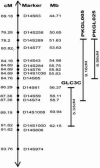Primary congenital glaucoma localizes to chromosome 14q24.2-24.3 in two consanguineous Pakistani families
- PMID: 18776954
- PMCID: PMC2530517
Primary congenital glaucoma localizes to chromosome 14q24.2-24.3 in two consanguineous Pakistani families
Abstract
Purpose: Two consanguineous Pakistani families with autosomal recessive primary congenital glaucoma were recruited to identify the disease locus.
Methods: Ophthalmic examinations including slit lamp biomicroscopy and applanation tonometry were employed to classify the phenotype. Blood samples were collected and genomic DNA was extracted. A genome wide scan was performed on both families with 382 polymorphic microsatellite markers. Two point LOD scores were calculated, and haplotypes were constructed to define the disease interval.
Results: Clinical records and ophthalmic examinations suggest that affected individuals in families PKGL005 and PKGL025 have primary congenital glaucoma. Maximum two-point LOD scores of 5.88 with D14S61 at theta=0 and 6.19 with D14S43 at theta=0 were obtained for families PKGL005 and PKGL025, respectively. Haplotype analysis defined the disease locus as spanning a 6.56 cM (~4.2 Mb) genetic interval flanked by D14S289 proximally and D14S85 distally.
Conclusions: Linkage analysis localizes autosomal recessive primary congenital glaucoma to chromosome 14q24.2-24.3 in consanguineous Pakistani families.
Figures


Similar articles
-
Localization of autosomal recessive congenital cataracts in consanguineous Pakistani families to a new locus on chromosome 1p.Mol Vis. 2007 Sep 10;13:1635-40. Mol Vis. 2007. PMID: 17893665
-
Novel CYP1B1 mutations in consanguineous Pakistani families with primary congenital glaucoma.Mol Vis. 2008;14:2002-9. Epub 2008 Nov 3. Mol Vis. 2008. PMID: 18989382 Free PMC article.
-
A new locus for autosomal recessive nuclear cataract mapped to chromosome 19q13 in a Pakistani family.Invest Ophthalmol Vis Sci. 2005 Feb;46(2):623-6. doi: 10.1167/iovs.04-0955. Invest Ophthalmol Vis Sci. 2005. PMID: 15671291
-
Novel mutations in LTBP2 identified in familial cases of primary congenital glaucoma.Mol Vis. 2020 Feb 24;26:14-25. eCollection 2020. Mol Vis. 2020. PMID: 32165823 Free PMC article.
-
A gene for primary congenital glaucoma is not linked to the locus on chromosome 1q for autosomal dominant juvenile-onset open angle glaucoma.J Glaucoma. 1996 Dec;5(6):416-21. J Glaucoma. 1996. PMID: 8946299
Cited by
-
P.Gly61Glu and P.Arg368His Mutations in CYP1B1 that Cause Congenital Glaucoma may be Relatively Frequent in Certain Regions of Gilan Province, Iran.J Ophthalmic Vis Res. 2018 Oct-Dec;13(4):403-410. doi: 10.4103/jovr.jovr_147_17. J Ophthalmic Vis Res. 2018. PMID: 30479709 Free PMC article.
-
A genome-wide association study for primary open angle glaucoma and macular degeneration reveals novel Loci.PLoS One. 2013;8(3):e58657. doi: 10.1371/journal.pone.0058657. Epub 2013 Mar 11. PLoS One. 2013. PMID: 23536807 Free PMC article.
-
Screening of the LTBP2 gene in a north Indian population with primary congenital glaucoma.Mol Vis. 2013;19:78-84. Epub 2013 Jan 17. Mol Vis. 2013. PMID: 23378721 Free PMC article.
-
Update in Genetics and Surgical Management of Primary Congenital Glaucoma.Turk J Ophthalmol. 2019 Dec 31;49(6):347-355. doi: 10.4274/tjo.galenos.2019.28828. Turk J Ophthalmol. 2019. PMID: 31893591 Free PMC article. Review.
-
LTBP2 and CYP1B1 mutations and associated ocular phenotypes in the Roma/Gypsy founder population.Eur J Hum Genet. 2011 Mar;19(3):326-33. doi: 10.1038/ejhg.2010.181. Epub 2010 Nov 17. Eur J Hum Genet. 2011. PMID: 21081970 Free PMC article.
References
-
- Sarfarazi M. Recent advances in molecular genetics of glaucomas. Hum Mol Genet. 1997;6:1667–77. - PubMed
-
- Vasiliou V, Gonzalez FJ. Role of CYP1B1 in Glaucoma. Annu Rev Pharmacol Toxicol. 2008;48:333–58. - PubMed
-
- Ho CL, Walton DS. Primary congenital glaucoma: 2004 update. J Pediatr Ophthalmol Strabismus. 2004;41:271–88. - PubMed
-
- Wiggs JL, Auguste J, Allingham RR, Flor JD, Pericak-Vance MA, Rogers K, LaRocque KR, Graham FL, Broomer B, Del Bono E, Haines JL, Hauser M. Lack of association of mutations in optineurin with disease in patients with adult-onset primary open-angle glaucoma. Arch Ophthalmol. 2003;121:1181–3. - PMC - PubMed
-
- Reddy ABM, Panicker SG, Mandal AK, Hasnain SE, Balasubramanian D. Identification of R368H as a predominant CYP1B1 allele causing primary congenital glaucoma in Indian patients. Invest Ophthalmol Vis Sci. 2003;44:4200–3. - PubMed
Publication types
MeSH terms
LinkOut - more resources
Full Text Sources
Medical
Molecular Biology Databases
Miscellaneous
